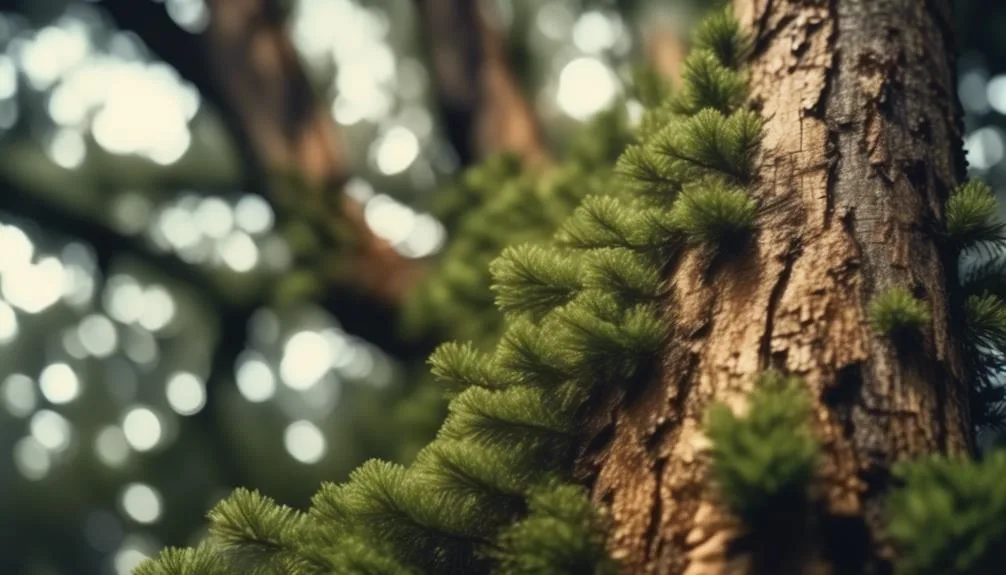If your cedar trees seem unwell, they might have common diseases like Cedar Apple Rust or Cytospora Canker.
But don't worry! There are treatments and ways to prevent these issues.
Understanding these diseases and how to deal with them is important for keeping your cedar trees healthy and strong.
Stay tuned to learn more about how to protect your beloved cedars from these ailments.
Cedar Apple Rust
If you have cedar trees and apple trees, you may encounter the fungal disease known as Cedar Apple Rust, which can significantly impact the health of your trees.
Preventative measures for Cedar Apple Rust include planting cedar trees away from apple trees, as the disease spreads when the two species are in close proximity. Additionally, removing any cedar trees within a 2-3 mile radius of apple trees can help prevent the spread of this disease.
Treatment options for Cedar Apple Rust involve the use of fungicidal sprays. These should be applied preventatively in the spring before the fungal spores are released, and then continued on a regular schedule throughout the growing season.
It's important to monitor the trees closely and act promptly at the first sign of infection to prevent the disease from spreading.
Cytospora Canker
Cytospora Canker is a common disease affecting cedar trees, caused by the fungal pathogen Cytospora. To manage fungal infections, it's crucial to promptly address any wounds on the tree and employ proper tree wound care techniques. Here are some effective methods for managing Cytospora Canker:
| Fungal Infection Management | Tree Wound Care Techniques |
|---|---|
| Remove infected branches promptly to prevent further spread of the disease | Keep the tree healthy and well-watered to promote its natural defenses |
| Apply a fungicide to the affected areas according to the manufacturer's instructions | Prune branches properly to prevent unnecessary wounds and stress on the tree |
| Monitor the tree's overall health and address any signs of stress promptly | Keep the tree's bark intact to minimize entry points for pathogens |
| Avoid excessive use of nitrogen-based fertilizers, as they can increase susceptibility to Cytospora Canker | Apply a protective wound dressing on any pruning cuts to aid in healing |
Needle Blight
Needle blight is a fungal disease that commonly affects cedar trees, causing discoloration and premature shedding of needles. If left untreated, it can lead to defoliation and weaken the tree's overall health.
Here are some tips to help you manage needle blight and prevent its spread:
- Proper Pruning: Remove and destroy infected branches to prevent the disease from spreading further.
- Fungicide Application: Utilize fungicides specifically formulated to target needle blight. Follow the manufacturer's instructions for application frequency and dosage.
- Tree Health Maintenance: Ensure your cedar trees are well-maintained with proper watering, mulching, and fertilization to strengthen their natural defenses against diseases.
Effective disease prevention and needle blight management are crucial for maintaining the health and vitality of your cedar trees. By implementing these strategies, you can help safeguard your trees from the damaging effects of needle blight.
Cedar Bark Beetle Infestation
Amidst the challenges faced by cedar trees, cedar bark beetle infestation poses a significant threat to their health and vitality. Preventing beetle infestation is crucial for managing cedar tree health.
Keep your cedar trees healthy and well-watered, as beetles are attracted to stressed or weakened trees. Regularly inspect your cedar trees for signs of beetle infestation, such as sawdust-like material around the base of the tree and small holes in the bark.
If you suspect beetle activity, consider using insecticidal sprays or contacting a professional arborist to assess the situation. Removing and destroying infested trees can also help prevent the spread of beetles to healthy trees.
Root Rot
Preventing beetle infestation is crucial for managing the health of cedar trees. Another common threat to their well-being is root rot. Root rot is caused by various fungi that thrive in moist soil, leading to decay and weakening of the tree's root system.
To combat root rot and ensure the well-being of your cedar trees, consider the following:
- Fungal Treatment and Prevention: Use fungicidal treatments to control the spread of root rot. Additionally, ensure proper air circulation around the tree to discourage fungal growth.
- Soil Drainage and Management: Improve soil drainage by avoiding overwatering and planting cedar trees in well-draining soil. Additionally, mulching can help regulate soil moisture levels and prevent waterlogging.
- Regular Inspection: Routinely inspect the tree's roots for signs of decay, such as discoloration and mushiness, to catch and address root rot early.
Conclusion
To safeguard the health of your cedar trees, staying vigilant against common diseases is crucial. These diseases include cedar apple rust, cytospora canker, needle blight, cedar bark beetle infestation, and root rot.
Timely identification and treatment are key to preventing widespread damage. By providing attentive care, you can ensure the longevity and beauty of your cedar trees.

My interest in trees started when I first saw the giant sequoias in Yosemite.
I was a teenager then, and I remember thinking, “I need to learn more about this.”
That moment stuck with me.
A few years later, I went on to study forestry at Michigan Tech.
Since graduating, I’ve worked in a mix of hands-on tree care and community education.
I’ve spent over ten years helping people understand how to plant, maintain, and protect the trees in their neighborhoods.
I don’t see trees as just part of the landscape.
They are living things that make a real difference in our daily lives.
